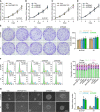Long Non-Coding RNA MAPK8IP1P2 Inhibits Lymphatic Metastasis of Thyroid Cancer by Activating Hippo Signaling via Sponging miR-146b-3p
- PMID: 33489905
- PMCID: PMC7817949
- DOI: 10.3389/fonc.2020.600927
Long Non-Coding RNA MAPK8IP1P2 Inhibits Lymphatic Metastasis of Thyroid Cancer by Activating Hippo Signaling via Sponging miR-146b-3p
Abstract
The principal issue derived from thyroid cancer is its high propensity to metastasize to the lymph node. Aberrant exprssion of long non-coding RNAs have been extensively reported to be significantly correlated with lymphatic metastasis of thyroid cancer. However, the clinical significance and functional role of lncRNA-MAPK8IP1P2 in lymphatic metastasis of thyroid cancer remain unclear. Here, we reported that MAPK8IP1P2 was downregulated in thyroid cancer tissues with lymphatic metastasis. Upregulating MAPK8IP1P2 inhibited, while silencing MAPK8IP1P2 enhanced anoikis resistance in vitro and lymphatic metastasis of thyroid cancer cells in vivo. Mechanistically, MAPK8IP1P2 activated Hippo signaling by sponging miR-146b-3p to disrupt the inhibitory effect of miR-146b-3p on NF2, RASSF1, and RASSF5 expression, which further inhibited anoikis resistance and lymphatic metastasis in thyroid cancer. Importantly, miR-146b-3p mimics reversed the inhibitory effect of MAPK8IP1P2 overexpression on anoikis resistance of thyroid cancer cells. In conclusion, our findings suggest that MAPK8IP1P2 may serve as a potential biomarker to predict lymphatic metastasis in thyroid cancer, or a potential therapeutic target in lymphatic metastatic thyroid cancer.
Keywords: Hippo signaling; MAPK8IP1P2; anoikis resistance; lymph node metastasis; thyroid cancer.
Copyright © 2021 Liu, Fu, Bian, Fu, Xin, Liang, Li, Zhao, Fang, Li, Zhang, Dionigi and Sun.
Conflict of interest statement
The authors declare that the research was conducted in the absence of any commercial or financial relationships that could be construed as a potential conflict of interest.
Figures







Similar articles
-
MicroRNA-146b-3p Promotes Cell Metastasis by Directly Targeting NF2 in Human Papillary Thyroid Cancer.Thyroid. 2018 Dec;28(12):1627-1641. doi: 10.1089/thy.2017.0626. Epub 2018 Oct 27. Thyroid. 2018. PMID: 30244634 Free PMC article.
-
MicroRNA-363-3p suppresses anoikis resistance in human papillary thyroid carcinoma via targeting integrin alpha 6.Acta Biochim Biophys Sin (Shanghai). 2019 Aug 5;51(8):807-813. doi: 10.1093/abbs/gmz066. Acta Biochim Biophys Sin (Shanghai). 2019. PMID: 31257410
-
miR-424-5p Promotes Anoikis Resistance and Lung Metastasis by Inactivating Hippo Signaling in Thyroid Cancer.Mol Ther Oncolytics. 2019 Nov 13;15:248-260. doi: 10.1016/j.omto.2019.10.008. eCollection 2019 Dec 20. Mol Ther Oncolytics. 2019. PMID: 31890869 Free PMC article.
-
Knockdown of microRNA-103a-3p inhibits the malignancy of thyroid cancer cells through Hippo signaling pathway by upregulating LATS1.Neoplasma. 2020 Nov;67(6):1266-1278. doi: 10.4149/neo_2020_191224N1331. Epub 2020 Aug 4. Neoplasma. 2020. PMID: 32749848
-
MicroRNA-146b: A Novel Biomarker and Therapeutic Target for Human Papillary Thyroid Cancer.Int J Mol Sci. 2017 Mar 15;18(3):636. doi: 10.3390/ijms18030636. Int J Mol Sci. 2017. PMID: 28294980 Free PMC article. Review.
Cited by
-
Pien Tze Huang Inhibits Migration and Invasion of Hepatocellular Carcinoma Cells by Repressing PDGFRB/YAP/CCN2 Axis Activity.Chin J Integr Med. 2024 Feb;30(2):115-124. doi: 10.1007/s11655-022-3533-8. Epub 2022 Aug 10. Chin J Integr Med. 2024. PMID: 35947230
-
Interpretable machine learning models for predicting skip metastasis in cN0 papillary thyroid cancer based on clinicopathological and elastography radiomics features.Front Oncol. 2025 Jan 7;14:1457660. doi: 10.3389/fonc.2024.1457660. eCollection 2024. Front Oncol. 2025. PMID: 39868368 Free PMC article.
-
Hsa_Circ_0134426 Attenuates the Malignant Biological Behaviors of Multiple Myeloma by Suppressing miR-146b-3p to Upregulate NDNF.Mol Biotechnol. 2023 Jul;65(7):1165-1177. doi: 10.1007/s12033-022-00618-6. Epub 2022 Dec 2. Mol Biotechnol. 2023. PMID: 36460812
-
Overexpressed lncRNA LINC00893 Suppresses Progression of Colon Cancer by Binding with miR-146b-3p to Upregulate PRSS8.J Oncol. 2022 May 5;2022:8002318. doi: 10.1155/2022/8002318. eCollection 2022. J Oncol. 2022. PMID: 35571488 Free PMC article.
-
Regulation of RASSF by non-coding RNAs in different cancers: RASSFs as masterminds of their own destiny as tumor suppressors and oncogenes.Noncoding RNA Res. 2022 May 13;7(2):123-131. doi: 10.1016/j.ncrna.2022.04.001. eCollection 2022 Jun. Noncoding RNA Res. 2022. PMID: 35702574 Free PMC article. Review.
References
-
- Hay ID, Thompson GB, Grant CS, Bergstralh EJ, Dvorak CE, Gorman CA, et al. Papillary thyroid carcinoma managed at the Mayo Clinic during six decades (1940-1999): temporal trends in initial therapy and long-term outcome in 2444 consecutively treated patients. World J Surg (2002) 26:879–85. 10.1007/s00268-002-6612-1 - DOI - PubMed
LinkOut - more resources
Full Text Sources
Other Literature Sources
Research Materials
Miscellaneous

